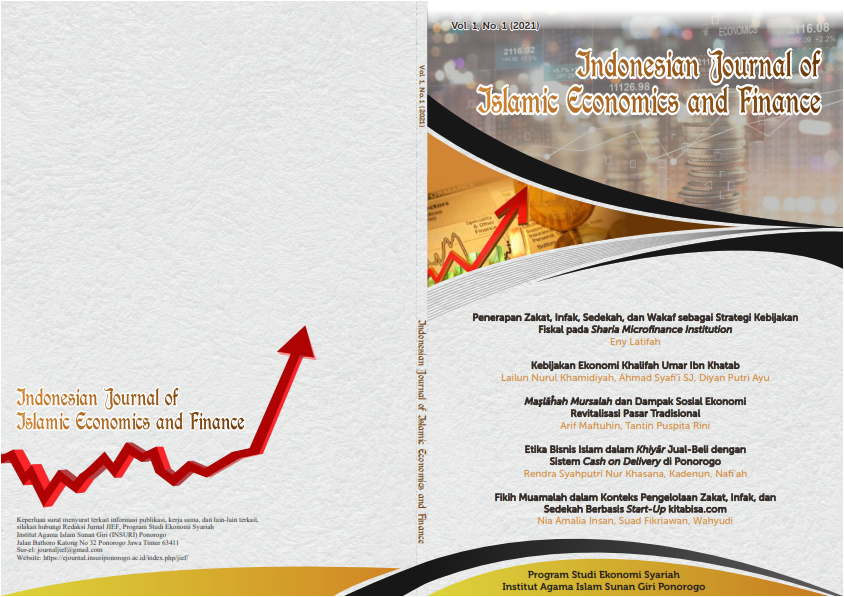Comparative Analysis of Operational and Liquidity Risks of Islamic Banks in the ASEAN Region Using Basel III
DOI:
https://doi.org/10.37680/ijief.v4i2.6674Keywords:
Operational Risk, Liquidity, Basel III, Islamic BanksAbstract
This research aims to analyze the differences in operational and liquidity risks of Islamic banks in the ASEAN region based on the Basel III framework. The study employs a quantitative methodology, utilizing the Kruskal-Wallis analysis and Mann-Whitney U test, drawing on financial reports from Islamic banks from 2021 to 2023. Key indicators examined include the Operational Risk Capital Charge (ORCC), Net Stable Funding Ratio (NSFR), and Liquidity Coverage Ratio (LCR). The findings reveal significant differences in the management of operational risk (ORCC) and long-term funding stability (NSFR), while no significant differences were observed in short-term liquidity (LCR). It was noted that predominantly Muslim countries are better equipped to handle operational risks, whereas banks in smaller markets face liquidity challenges. However, the study is limited to Islamic banks in five ASEAN countries and does not consider external variables such as macroeconomic conditions. Overall, these findings contribute to the existing literature on risk management in Islamic banks within the ASEAN region and offer valuable insights for regulators to develop policies tailored to local characteristics.
References
Aliyu, S., Hassan, M. K., Mohd Yusof, R., & Naiimi, N. (2016). Islamic Banking Sustainability: A Review of Literature and Directions for Future Research. Emerging Markets Finance and Trade, 1–31. https://doi.org/10.1080/1540496X.2016.1262761
Basel Committee on Banking Supervision. (2015). Guidance on the application of the Core principles for effective banking supervision to the regulation and supervision of institutions relevant to financial inclusion (Issue March).
Hasan, M. M., & Dridi, J. (2010). The effects of the global crisis on Islamic and conventional banks: A comparative study. https://papers.ssrn.com/sol3/papers.cfm?abstract_id=1750689
Hasan, M., Noercahyo, A., Rani, A. E., Salsabilla, N. A., & Izzati, S. N. (2021). Pengembangan ekonomi kreatif sektor UMKM di masa pandemi covid-19. Jurnal Ekonomi Pendidikan Dan Kewirausahaan, 9(2), 125–138.
IFSB. (2023). Islamic Financial Services Industry: Stability Report 2023. FRB Stability Report.
Iqbal, Z., & Mirakhor, A. (2018). Pengantar Keuangan Islam Teori dan Praktik. Kencana Prenada.
Islamiyah, N. (2023). Analisis komparatif risiko keuangan pada perbankan Syariah di ASEAN [PhD Thesis, Universitas Islam Negeri Maulana Malik Ibrahim]. http://etheses.uin-malang.ac.id/id/eprint/49186
Isnurhadi, Sulastri, Saftiana, Y., & Jie, F. (2022). Banking industry sustainable growth rate under risk: Empirical study of the banking industry in ASEAN countries. Sustainability, 15(1), 564.
Kammer, M. A., Norat, M. M., Pinon, M. M., Prasad, A., Towe, M. C. M., & Zeidane, M. Z. (2015). Islamic finance: Opportunities, challenges, and policy options. https://books.google.com/books?hl=id&lr=&id=tKoZEAAAQBAJ&oi=fnd&pg=PA4&dq=Kammer,+A.,+Norat,+M.,+Pinon,+M.,+Prasad,+A.,+Towe,+C.,+%26+Zeidane,+Z.+(2015).+Islamic+Finance:+Opportunities,+Challenges,+and+Policy+Options.+Staff+Discussion+Notes,+15(5),+1.+https://doi.org/10.5089/9781498325035.006&ots=jKdOzl0VZo&sig=YENX9N_1nmOnqubm8t7N0fW3UGI
Laeven, M. L., Igan, M. D., Claessens, M. S., & Dell’Ariccia, M. G. (2010). Lessons and policy implications from the global financial crisis. International Monetary Fund. https://books.google.com/books?hl=id&lr=&id=Ro4YEAAAQBAJ&oi=fnd&pg=PA3&dq=Claessens,+S.,+Laeven,+L.,+Igan,+D.,+%26+Dell%E2%80%99Ariccia,+G.+(2010).+Lessons+and+Policy+Implications+From+the+Global+Financial+Crisis.+IMF+Working+Papers,+10(44),+1.+https://doi.org/10.5089/9781451963021.001&ots=AuzzuHPSEk&sig=EV33EQh_XxffdzQ4vZDnY8aPyWw
Le, T. N. L., Nasir, M. A., & Huynh, T. L. D. (2023). Capital requirements and banks performance under Basel-III: A comparative analysis of Australian and British banks. The Quarterly Review of Economics and Finance, 87, 146–157.
Mahisi, P. P. W. N., & Usman, B. (2024). The Effect of Basel III Liquidity, Credit Risk, and Market Risk on the Profitability of Commercial Banks in Indonesia. Indonesian Interdisciplinary Journal of Sharia Economics (IIJSE), 7(2), 3416–3440.
Mattayaphutron, S. (2022). Exploring the nexus among the macroprudential policies, funding liquidity risk and bank risk of commercial banks in leading South East Asian economies. The Asian Bulletin of Contemporary Issues in Economics and Finance, 2(1), 1–21.
Mishkin, F. S. (2008). The Economics Of Money, Banking, and Financial Markets (Ekonom iUang, Perbankan, dan Pasar Keuangan). Edisi Kedelapan (Terjemahan), Penerbit Salemba Empat: Jakarta.
Misman, F. N., & Bhatti, M. I. (2020). The determinants of credit risk: An evidence from ASEAN and GCC Islamic banks. Journal of Risk and Financial Management, 13(5), 89.
Naibaho, E. A. B., & Mayayogini, N. M. C. (2023). The impact of risk management on firm performance: Corporate governance as moderating variable. Media Ekonomi Dan Manajemen, 38(1), 129–146.
Natsir, K., Bangun, N., & Waani, A. M. (2023). Analisis Faktor-Faktor Yang Mempengaruhi Likuiditas Pasar Saham. Jurnal Ekonomi, 28(2), 155–176.
Perotti, R. (2007). Fiscal policy in developing countries. https://books.google.com/books?hl=id&lr=&id=IY0UwuYCXTMC&oi=fnd&pg=PA1&dq=Perotti,+R.+(2007).+Fiscal+policy+in+developing+countries.+September.&ots=biuqtmFMuu&sig=acKGcSvdGRhl9s1XtArCVOmPrz0
Putra, P. A. (2023). PENERAPAN MANAJEMEN RESIKO LIKUIDITAS PADA BANK SYARIAH. Jurnal Tabarru’: Islamic Banking and Finance, 6(1), 81–91.
Safitri, J., & Geraldina, I. (2024). The Impact of Liquidity Strategy on Banking Performance in the ASEAN Region. Indonesian Journal of Business Analytics, 4(2), 611–622.
Song, M. I., & Oosthuizen, C. (2014). Islamic banking regulation and supervision: Survey results and challenges. International Monetary Fund. https://books.google.com/books?hl=id&lr=&id=EMUaEAAAQBAJ&oi=fnd&pg=PA4&dq=Song,+I.,+%26+Oosthuizen,+C.+(2014).+Islamic+Banking+Regulation+and+Supervision:+Survey+Results+and+Challenges.+IMF+Working+Papers,+14(220),+1.+https://doi.org/10.5089/9781498380928.001&ots=et4sddHf4E&sig=oeNrh0m7ItCrmnGjgQi4MCqUygs
Sugiyono, D. (2013). Metode penelitian pendidikan pendekatan kuantitatif, kualitatif dan R&D. https://digilib.unigres.ac.id/index.php?p=show_detail&id=43
Ummah, M. S. (2014). Corporate governance of state-owned enterprises: A toolkit. The World Bank.
Wahyuni, A., & Sukirno, S. (2016). Analisis Perbandingan Kinerja Keuangan Perbankan Asean (Studi Pada Bank Umum Indonesia, Thailand Dan Filipina). Nominal Barometer Riset Akuntansi Dan Manajemen, 5(2), 1–5.
Widarjono, A., Wijayanti, D., & Suharto, S. (2022). Funding liquidity risk and asset risk of Indonesian Islamic rural banks. Cogent Economics & Finance, 10(1), 2059911. https://doi.org/10.1080/23322039.2022.2059911
Zakhariah, C., & Hesniati, H. (2022). Comparative Analysis of Islamic Commercial Banks and Sharia Business Units in Indonesia. Jurnal Ilmiah Ekonomi Islam, 8(2), 1393–1403.
Downloads
Published
How to Cite
Issue
Section
License
Copyright:
An author who publishes in Indonesian Journal of Islamic Ekonomics and Finance agrees to the following terms:
- Author retains the copyright and grants the journal the right of first publication of the work simultaneously licensed under a Creative Commons Attribution-NonCommercial 4.0 International License that allows others to share the work with an acknowledgment of the work's authorship and initial publication in this journal.
- Author is able to enter into separate, additional contractual arrangements for the non-exclusive distribution of the journal's published version of the work (e.g., post it to an institutional repository or publish it in a book) with the acknowledgment of its initial publication in this journal.
- Author is permitted and encouraged to post his/her work online (e.g., in institutional repositories or on their website) prior to and during the submission process, as it can lead to productive exchanges, as well as earlier and greater citation of the published work (See The Effect of Open Access).
License:
-
Attribution — You must give appropriate credit, provide a link to the license, and indicate if changes were made. You may do so in any reasonable manner, but not in any way that suggests the licensor endorses you or your use.
-
NonCommercial — You may not use the material for commercial purposes.
-
No additional restrictions — You may not apply legal terms or technological measures that legally restrict others from doing anything the license permits.
You are free to:
- Share — copy and redistribute the material in any medium or format
- Adapt — remix, transform, and build upon the material

This work is licensed under a Creative Commons Attribution-NonCommercial 4.0 International License.



.png)







